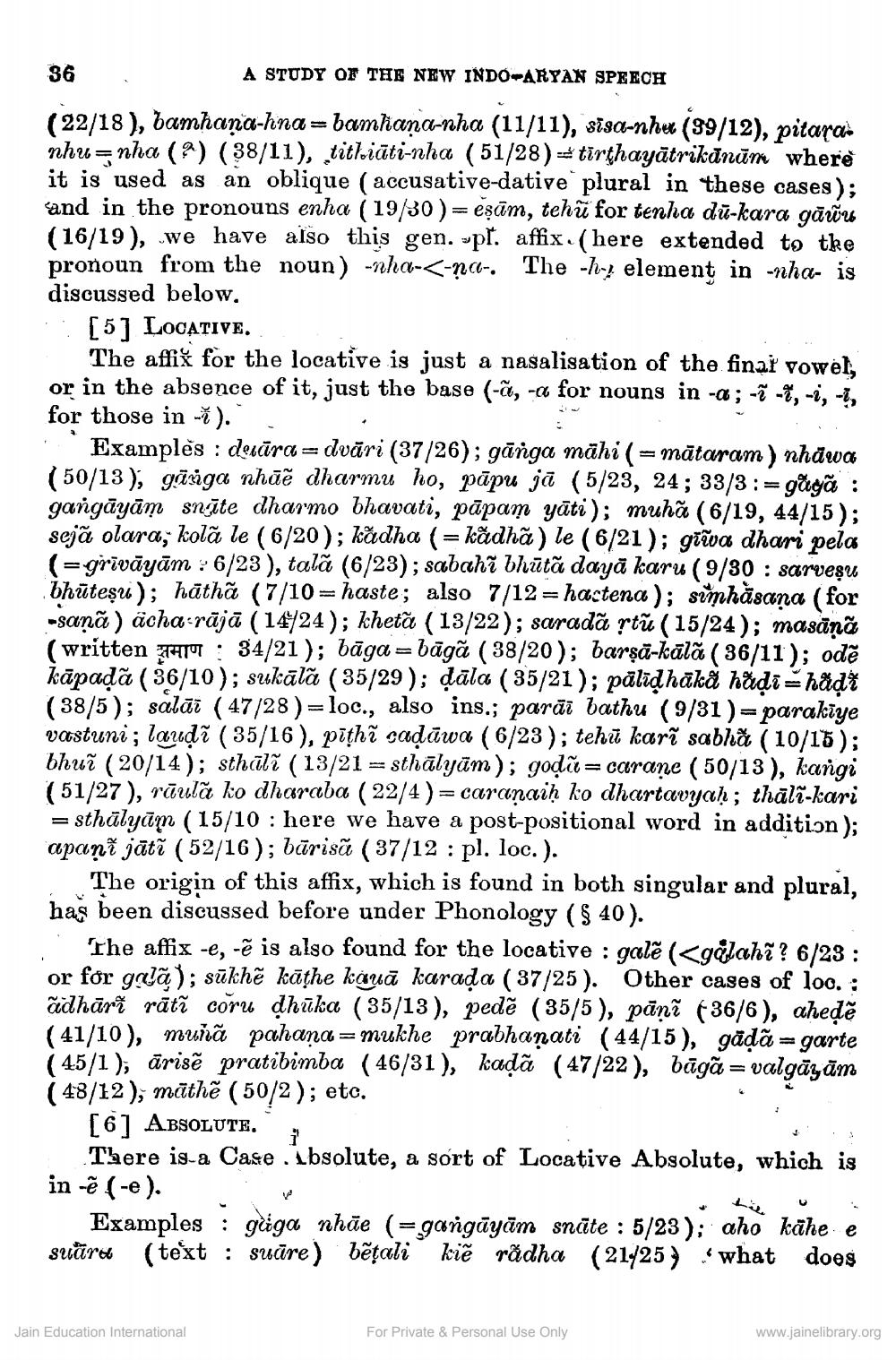________________
36
A STUDY OF THE NEW INDO-ARYAN SPEECH
(22/18 ), bambama-hma=bcomban-aha (11/11), 8%8C-nhee (89/12), pitaya mhd=ma (*) (28/11), titl-ti-ba ( 51/28)à tĩnhagặt kumo where it is used as an oblique (accusative-dative plural in these cases); and in the pronouns enha (19/30 )= eşām, tehū for tenha dū-kara gāūz (16/19), we have also this gen. npr. affix. (here extended to the pronoun from the noun) -nha-<-na-. The -hz element in -nha- is discussed below. :: [5] LOCATIVE.
The affix for the locative is just a nasalisation of the finai vowel, or in the absence of it, just the base (-ã, -for nouns in -a; -7 -7, -1, -, for those in -ě).
. Examples : devāra= dvāri (37/26); gānga mähi (= mātaram ) nhawa (50/13); gārga nhūč dharmu ho, pāpu jā (5/23, 24; 33/3 := gãgã : gangāyām sncīte dharmo bhavati, pāpam yāti); muhã (6/19, 44/15); sejã olara; kolã le (6/20); kādha (= kādhã) le (6/21); grāva dhari pelas (=grīvāyām 6/23), tală (6/23); sabahi bhūtā dayā karu (9/30 : sarvesu bhūteşu); häthã (7/10=haste; also 7/12=hastena); simhăsana (for -saņā) acha-rājā ( 14/24); khetă (13/22); saradã rtū (15/24); masānā (written a : 34/21 ); bāga = būgă (38/20); barşā-kālā ( 36/11); odě kāpađã ( 36/10); sukālā ( 35/29); dāla ( 35/21); pālīdhakå hädi = hadt (38/5); salãi ( 47/28 )=loc., also ins.; parāi bathu (9/31 )= parakiye vastuni ; laudã (35/16 ), pīthĩ cadāwa (6/23); tehū karī sabhã (10/15 ); bhuž (20/14); sthal (13/21 = sthālyām); godã= carane ( 50/13), kangi (51/27), rāulā ko dharaba (22/4)= caranaiḥ ko dhartavyaḥ; thāli-kari = sthālyān (15/10 : here we have a post-positional word in addition); apaņī jātī (52/16); būrisã (37/12 : pl. loc.).
The origin of this affix, which is found in both singular and plural, has been discussed before under Phonology (40).
The affix -e, -ē is also found for the locative : galē (<gålahł? 6/23 : or för gada); sūkhē kāthe kauā karada (37/25). Other cases of loo. : ãdhārī rātã coru dhūka (35/13), pedě (35/5 ), pāņā (36/6), ahedě ( 41/10), muñã pahana = mukhe prabhanati (44/15), gađã=garte ( 45/1); ārisē pratibimba (46/31), kađã (47/22), bāgã = valgāzām ( 48/12); müthể (50/2); etc.
[6] ABSOLUTE.
There is a Case. Absolute, a sort of Locative Absolute, which is in ě (-e). .
Examples : guga nhãe (=gangāyām snāte : 5/23); aho kähe e suara (text : suāre) bētali kič rădha (21425, what does
Jain Education International
For Private & Personal Use Only
www.jainelibrary.org




